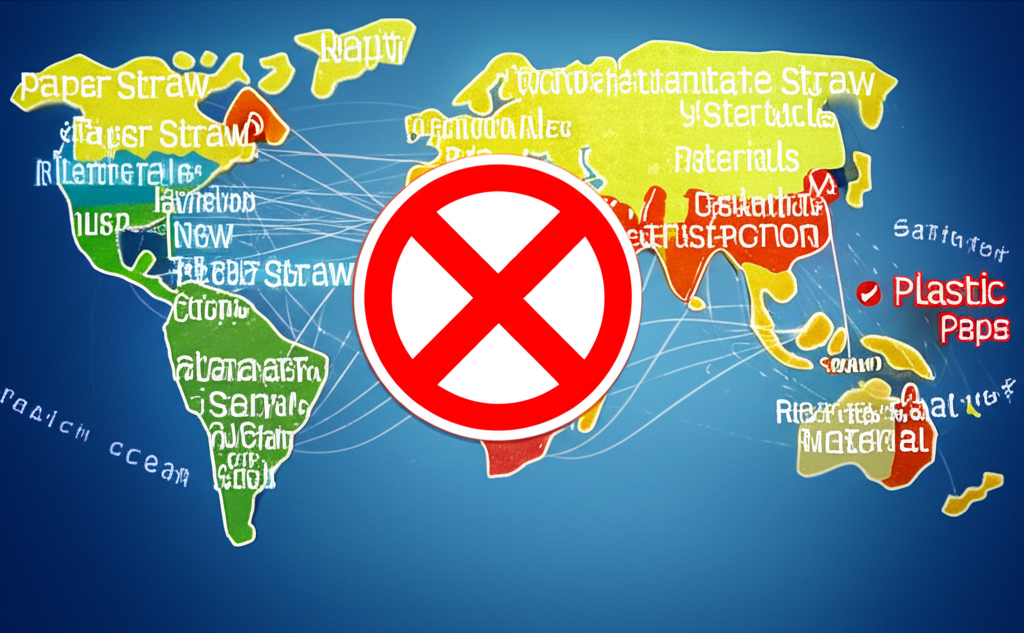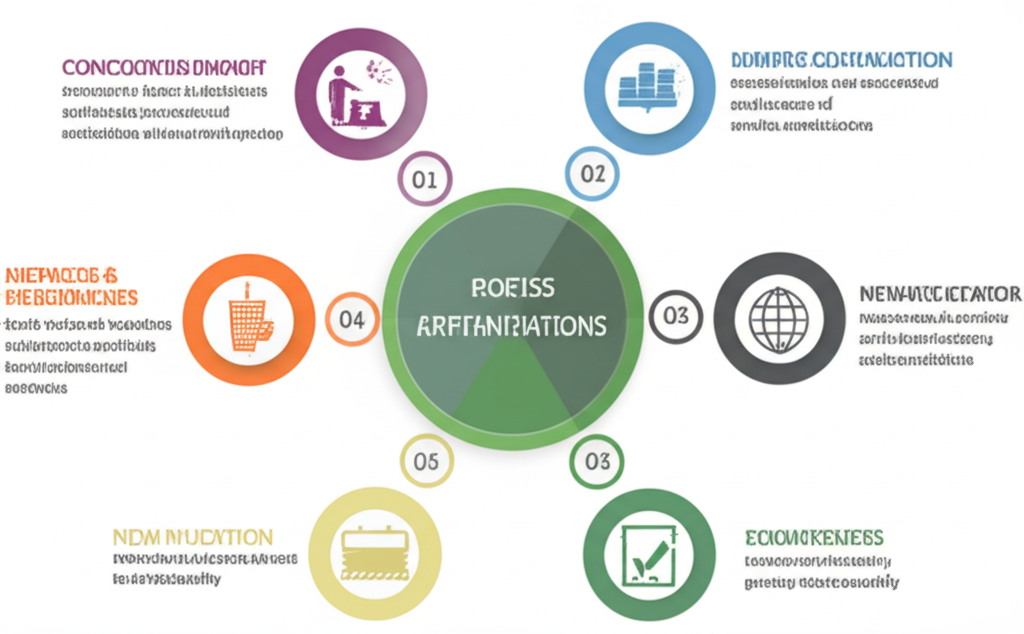
The procurement decisions facing B2B leaders today are more complex than ever, especially when it comes to seemingly simple items like drinking straws. The shift towards sustainable alternatives, once a clear path for environmentally conscious businesses, has become complicated by recent policy changes. A new U.S. federal directive has reignited the debate around paper straws, challenging their efficacy and cost-effectiveness, and leaving many supply chain executives and operations directors to re-evaluate their compliance strategies and sustainability commitments. This post will delve into the intricacies of current straw policies, compare material options, and outline strategic pathways for businesses to maintain compliance, optimize operations, and uphold their brand values.
A Shifting Compliance Landscape: Re-Evaluating Your Single-Use Strategy
For years, the trend for businesses seeking to align with growing environmental concerns and stricter regulations was clear: phase out plastic straws in favor of paper or other biodegradable options. Cities and states across the U.S. and numerous countries globally adopted bans on single-use plastics, creating a strong market pull for alternatives. However, the regulatory environment is rarely static, and a significant pivot at the U.S. federal level has introduced new considerations for organizations, particularly those involved in federal contracts or with a national presence.

InFebruary 2025, a U.S. executive order was signed, aiming to end the federal government’s procurement and provision of paper straws within federal buildings. This directive explicitly instructs federal agencies to cease buying paper straws and to eliminate policies that previously disfavored plastic alternatives. The stated rationale behind this shift is multifold: claims that paper straws “don’t work,” “don’t last very long,” are more expensive, and may contain potentially harmful chemicals like PFAS. It also controversially pointed out that some paper straws are individually wrapped in plastic, undermining their environmental benefit.
This federal action, while primarily impacting government operations, sends a strong signal that could ripple through the private sector, causing confusion among consumers and businesses alike. Previously, the Biden administration’s Executive Order 14057 (December 8, 2021) had aimed to phase out federal purchases of single-use plastics by 2027 for food service and packaging, and by 2035 for all federal operations. The swift reversal underscores the unpredictable nature of policy and the immediate challenge this presents for businesses that had structured their procurement and sustainability initiatives around previous directives. For procurement managers and operations directors, understanding this nuanced federal shift is critical to ensuring operational continuity and protecting brand reputation, especially if there’s any perceived misalignment with broader sustainability goals.
The Complex Web of Straw Regulations: Beyond Federal Directives
While the U.S. federal government has expressed a preference for moving away from paper straws, it’s imperative for businesses to recognize that this is not a universal ban, nor does it override existing state, local, or international regulations. The compliance landscape remains highly fragmented, demanding meticulous attention to detail from supply chain executives.

The Enduring State and Local Plastic Straw Bans in the U.S.:
Despite the federal pivot, numerous U.S. states and cities continue to uphold and enforce their bans or restrictions on single-use plastic straws. These local regulations often explicitly encourage or mandate the use of paper, compostable, or reusable alternatives, creating a patchwork of requirements across the country. Key examples include:
- California: Assembly Bill 1884 (2018) restricts full-service restaurants from automatically providing plastic straws.
- Seattle, Washington: A ban on plastic straws and utensils has been in effect since July 2018.
- Washington D.C.: Implemented its plastic straw ban in January 2019.
- Miami Beach, Florida: Enacted a ban on plastic straws in 2019.
- Other states like Maine, New Jersey, New York, Oregon, Rhode Island, Vermont, and Washington also maintain various restrictions, demonstrating a strong, ongoing local commitment to reducing plastic waste.
For businesses operating nationally, this means that a singular procurement strategy might not be feasible. A restaurant chain, for instance, must be prepared to comply with different straw requirements from one city to the next, even within the same state. This necessitates a robust understanding of local ordinances to avoid fines and maintain legal compliance.
Global Momentum Towards Single-Use Plastic Reduction:
Internationally, the prevailing trend continues to be a strong move away from single-use plastics. The European Union, for example, implemented a comprehensive ban on single-use plastic plates, cutlery, and straws, which came into effect in July 2021. This sweeping regulation affects all businesses importing into or operating within the EU, demanding a pivot towards sustainable alternatives.

Beyond Europe, other major economies and regions have followed suit:
- China: Since 2021, China has progressively banned single-use plastic bags and utensils from major cities, with a nationwide ban on single-use straws in the restaurant industry by the end of 2020.
- Canada: Announced plans to ban a wide range of single-use plastic products, including straws, by the end of 2022.
- United Kingdom: A ban on plastic straws, stirrers, and cotton buds, though initially delayed, came into effect in October 2020.
- Other Countries: Countries like France (targeting a ban on all single-use plastics by 2040), Spain, Italy, Bali, Jamaica, Belize, and Taiwan have also implemented or announced similar restrictions.
These global regulations underscore a clear international commitment to environmental protection and plastic waste reduction. For businesses with international supply chains or those targeting global markets, aligning with these broader trends is not just about compliance but also about maintaining a competitive edge and favorable brand perception in an increasingly eco-conscious global economy.
Consumer Sentiment and Operational Realities:
The debate around straw materials isn’t purely regulatory; it’s also shaped by consumer preferences and the practicalities of business operations. While the push for sustainability is strong, the user experience of paper straws has often been a point of contention. Surveys indicate a significant consumer preference for the durability and usability of plastic straws. An IPSOS survey from 2018 highlighted that a majority of Americans preferred plastic, with only 4% finding plastic straws “unpleasant” compared to seven times as many for paper straws. A 2023 YouGov poll further revealed that 33% of Americans “disliked” or “hated” paper straws, citing issues like quick breakdown, disintegration, and potential interference with the taste of beverages.

These concerns translate into real operational challenges for businesses. A disintegrating straw can lead to customer complaints, wasted product, and additional costs if multiple straws are needed per drink. Moreover, the environmental benefits of paper straws have faced scrutiny. Some studies suggest that the manufacturing process for paper straws can have a larger carbon footprint and require more water compared to plastic, challenging the perception of them as unequivocally superior in environmental impact. This complexity means businesses must balance compliance with customer satisfaction and the true environmental footprint of their chosen materials.
Strategic Solutions for Your Business: Adapting to the New Straw Economy
Navigating this intricate web of regulations, consumer preferences, and operational demands requires a robust, data-driven strategy. B2B leaders must go beyond simply reacting to policy changes and instead proactively explore sustainable and compliant solutions that align with their long-term business goals.
Comparing Your Options: A Business Decision Matrix
The choice of straw material has direct implications for cost, compliance, customer experience, and your brand’s sustainability narrative. Here’s a comparative look at common options:
| Feature | B2B Impact | Compliance Risk | ROI Potential |
|---|---|---|---|
| Paie de hârtie | Eco-friendly image (generally), widely available. Customer complaints due to durability issues. Higher cost than plastic. | Compliant with most state/local plastic bans and EU directives. Federal disfavor in US government contexts. Potential PFAS concern emerging. | Positive brand perception (for eco-conscious segment). Higher operational cost per unit. Risk of customer dissatisfaction. |
| Plastic Straws | Familiar, durable, low cost. High consumer preference. | Banned/restricted in many US states/cities and globally (EU, China, Canada). Federally re-emphasized in US government contexts. | Lower immediate cost. Significant brand perception risk due to environmental concerns. Potential for fines where banned. |
| Alternative Materials | (e.g., bamboo, metal, silicone, pasta, edible) Diverse options, varying durability & reusability. Often higher upfront cost. | Compliance varies by material & local regulations. Reusable options reduce waste. | Varies widely. Can be high for reusable (long-term savings). Can be low for single-use compostable. Strong positive brand perception (innovation, sustainability). Potential for premium pricing. Requires customer education for reusable options. |
întrebări frecvente
Legal & market context for paper and plastic straw policies (U.S. & global), with practical guidance for foodservice operators.
Are paper straws illegal in the U.S.?
No. There is no nationwide prohibition on paper straws for the general public or private businesses. A February 2025 federal executive order directs federal agencies to stop procuring and providing paper straws within federal buildings, but this is not a broad public ban. Many states and cities still restrict plastic straws, often encouraging paper or other alternatives.
What is the U.S. federal government’s current stance on paper straws?
As of Feb 2025, an executive order instructs federal facilities to discontinue paper straw procurement/provision, reversing direction from EO 14057 (Dec 2021). Rationale cited includes functionality, cost, potential PFAS concerns, and environmental efficacy (e.g., plastic wrapping). This stance applies to federal operations—not to private businesses or the general public.
Do plastic straw bans still exist in the U.S.?
Yes. Numerous states and municipalities (e.g., California, Seattle, Washington, D.C., Miami Beach) continue to enforce bans or “upon-request” policies for plastic straws. Operators must track local rules and update procurement and front-of-house SOPs accordingly.
What is the global trend regarding single-use plastic straws?
The trajectory is toward reduction or prohibition (e.g., EU Single-Use Plastics Directive, China’s restaurant straw restrictions, measures in Canada and Australia). Paper, plant-fiber, PHA/PLA, and edible options are scaling—but satisfaction varies by use case and drink type.
How do consumer preferences impact straw choices for businesses?
Consumers often prefer plastic for durability and mouthfeel; complaints about paper include sogginess and taste transfer. The winning strategy balances regulatory compliance with guest experience—for example, offering higher-performance compostable or edible straws for thick drinks, and a “straws-upon-request” policy to cut volume and cost.






